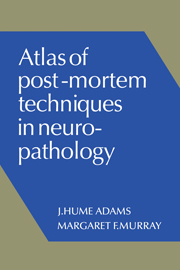7 - Dissection of the Fixed Brain
Published online by Cambridge University Press: 21 May 2010
Summary
The type of dissection depends to a certain extent on the site of any abnormality suspected of being present. Thus if there is thought to be a midline lesion affecting the third or the fourth ventricle, a midline sagittal section may be indicated (Figs. 7.23 – 7.25) and on occasion there may be good reason for slicing the brain in the planes demonstrated by the C–T head scanner. In general, however, the method described below is the most informative since it produces the maximum amount of information about distortion of the brain, the size and shape of the ventricular system, the presence of internal herniae and the appearances of the basal nuclei and the hippocampus (Ammon's horn).
Figs. 7.1 and 7.2 The first step is to make a transverse cut through the rostral pons. The scalpel blade should be large and have a broad base (e.g. Swann-Morton No. 22).
Place the brain, superior surface downwards, on a non–slippy surface – a sheet of cork is probably the best. Insert the scalpel blade right through the lateral surface of the pons just caudal to the oculo-motor nerves (arrow). Extend the cut transversely to the other side of the pons and lift the cerebellum and the brain stem away from the cerebral hemispheres. Care must be taken not to damage the medial parts of the temporal lobes with the scalpel.
- Type
- Chapter
- Information
- Atlas of Post-Mortem Techniques in Neuropathology , pp. 96 - 115Publisher: Cambridge University PressPrint publication year: 1982



